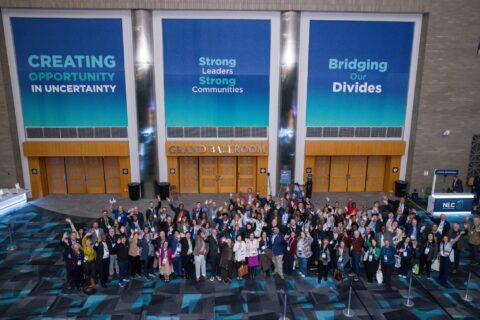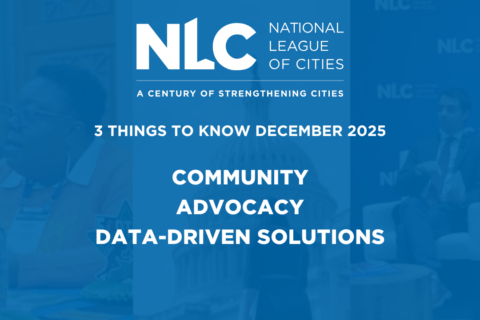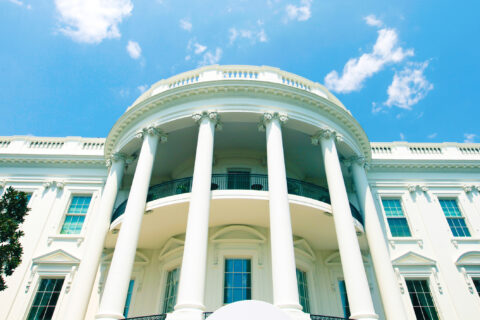On July 3, the House passed the Senate’s version of the One, Big, Beautiful Bill Act (H.R. 1) in a vote of 218-214. This followed the Senate’s passage on July 1 by a vote of 51-50, with Vice President Vance casting the deciding vote. Ultimately, Sens. Tillis (R-NC), Paul (R-KY) and Collins (R-ME) and Reps. Fitzpatrick (R-PA) and Massie (R-KY) voted against the bill, along with every Democrat and Independent. President Trump signed the bill into law on July 4.
Key Takeaways
- Key outreach from local leaders across the country produced several local government wins, including the preservation of tax-exemption on municipal bonds, a temporary raise to the SALT deduction and improved incentives for private investment in underserved communities.
- The bill rescinds a substantial amount of funding from the U.S. Department of Transportation Neighborhood Access and Equity grants, as well as unobligated funding from several emissions reduction grants under the U.S. Environmental Protection Agency.
- The bill maintains the direct pay mechanism created through the Inflation Reduction Act, it accelerates the phase out of tax credits for solar and wind projects and adds new requirements around supply chain components that will likely limit the ability of local governments to take advantage of the direct pay program.
- Significant cuts were made to social safety net programs, including $186 billion through 2034 for the Supplemental Nutrition Assistance Program (SNAP) and $1 trillion from Medicaid.
- The bill significantly expands federal immigration enforcement capacity while providing targeted funding to support local public safety and security efforts related to the 2026 FIFA World Cup and the 2028 Olympics, including $500 million to enhance local capabilities for detecting threats from unmanned aerial systems.
The latest estimates from the Congressional Budget Office (CBO) state that the “bill would decrease deficits by $0.4 trillion, relative to the budget enforcement baseline for consideration in the Senate. Compared with CBO’s January 2025 baseline budget projections, it would increase deficits over the 2025‑2034 period by $3.4 trillion.”
Here is a look at key provisions from the final bill that will impact local governments.
Support for Local Governments
- Municipal Bonds: While there was discussion about using the tax-exemption on municipal bonds as a “pay for,” the final bill preserved both the tax-exemption on municipal bonds and private activity bonds. This top priority for NLC is a critical financial win for cities, towns and villages across America.
- SALT: The bill temporarily raised the State and Local Tax (SALT) deduction cap from $10,000 to $40,000 with phaseouts starting for households earning over $500,000. The cap will increase by 1% annually through 2029. Starting in 2030, the cap will revert to $10,000.
- Incentives for Private Investment in Housing, Community, and Economic Development: The bill makes improvements to three federal programs that encourage private investment in underserved areas and households.
- The Opportunity Zone program, first launched in 2017, has been made permanent. The initial program, and its existing rules, will be replaced by an updated set of rules at the start of 2027. While there are several investor-side changes, some of the changes important to local governments include deeper targeting to economically distressed areas; an opportunity for Governors to re-designate opportunity zones every 10 years; enhanced investor incentives for projects in small and rural areas through Qualified Rural Opportunity Funds that target “areas other than a city or town with a population greater than 50,000”; and new reporting requirements that will enable the public, including local governments, to access more information on investments in their communities, including the location and amount of investment, and an analysis of the employment and housing impacts of Opportunity Zone projects.
- The Low-Income Housing Tax Credit (LIHTC) program will be permanently enhanced by authorizing a 12 percent credit allocation increase and lowering the bond financing threshold test to 25 percent. The permanence of these changes could drive additional investment to finance the production or preservation of approximately one million additional affordable rental homes over 10 years.
- The New Markets Tax Credit (NMTC) program was also made permanent. The program supports private investment in projects designed to create jobs and fill needs in underserved areas through Community Development Entities certified by the U.S. Treasury’s Community Development Financial Institutions Fund. Both the LIHTC and NMTC provisions were introduced as stand-alone bills that enjoyed broad bipartisan support before being incorporated into the One Big Beautiful Bill Act.
- No AI Preemption: While the House version of the bill included a 10-year moratorium preempting state and local governance of artificial intelligence, this provision was ultimately stripped from the bill by the Senate at the eleventh hour. The preemption, if passed, would have prohibited state and local governments from enforcing any law or regulation governing artificial intelligence for ten years, with extremely limited exceptions. The Senate language would also have conditioned payment of federal broadband infrastructure grant funds on compliance with this moratorium. Numerous organizations, including state and local governments, consumer protection organizations and the entertainment industry, opposed the measure, citing the lack of current federal regulation for AI. NLC and other local government entities also raised concerns that the moratorium could have unintended consequences, potentially even hampering adoption of AI for improvement of city services.
- State and Local Homeland Security Assistance: The bill also increases funding for state and local governments. This includes $10 billion in grants to reimburse states for prior border security efforts, $500 million to improve local capabilities to detect threats from unmanned aerial systems, $625 million for security planning related to the 2026 FIFA World Cup, and $1 billion for the 2028 Olympics. Additionally, the bill allocates $450 million to the Operation Stonegarden grant program, which supports partnerships between local law enforcement agencies and Border Patrol. These funding streams may provide local governments with new resources to strengthen public safety, upgrade infrastructure and enhance emergency preparedness in coordination with federal operations.
Areas of Concern for Local Governments
- Transportation and Other Grants Clawed Back: The bill rescinds a substantial amount of funding from the U.S. Department of Transportation Neighborhood Access and Equity grants, as well as unobligated funding from several emissions reduction grants under the U.S. Environmental Protection Agency. The original bill text repealed the authorization for these programs, but ultimately due to the Senate parliamentarian’s ruling, the programs are officially retained, but grantees lose any unobligated funding.
Several highway connectivity projects in multiple states, including TX, AL, UT, OH, ME and others, will not receive funding. It will be up to Congress to replace funding for these critical projects in the future, potentially in transportation reauthorization or appropriations.
Among the EPA grant rescissions that local governments are utilizing are:
- Climate Pollution Reduction Grants, which consisted of regional planning and implementation grants.
- Clean Heavy-duty Vehicles
- Environmental Justice/Climate Grants, including the Government-to-Government and Community Change grants. Many communities received termination notices from EPA for this program, which is the subject of a pending class action lawsuit against EPA.
These programs were one-time funding under the Inflation Reduction Act. NLC analysis of USAspending data indicates that most local governments that won grants under these programs have obligated awards, indicating that there might be little funding to claw back from local governments depending on how “unobligated is defined”.
Additionally, Greenhouse Gas Reduction Fund not only sees unobligated funding clawed back in the final bill, but the underlying authorization for the program is also repealed. The program is also subject to ongoing litigation.
- Clean Energy Tax Credits: While the final bill maintains the direct pay mechanism created through the Inflation Reduction Act, it accelerates the phase out of tax credits for solar and wind projects and adds new requirements around supply chain components that will likely limit the ability of local governments to take advantage of the direct pay program.
- For the Investment Tax Credit (48E) and Production Tax Credit (45Y), the final bill retains the tax credit for solar and wind projects that begin construction within one year after enactment. For solar and wind projects that begin construction after that time, they must be placed in service by the end of 2027 in order to receive the tax credit.
- For other clean energy projects, such as geothermal, hydropower, nuclear and battery storage, the investment and production tax credits are retained through 2033 and then begin a phase out through 2036. This is a longer time frame than originally provided through the IRA.
- Supply chain requirements related to Foreign Entities of Concern will apply to 48E and 45Y projects that begin construction after Dec. 31, 2025.
- For clean commercial vehicles (45W), the tax credit terminates for vehicles acquired after Sept. 30, 2025 and for alternative fuel charging (30C), the tax credit terminates for property placed in service after June 30, 2026.
- SNAP Cuts: The CBO’s latest cost estimate shows that the bill cuts federal funding for the Supplemental Nutrition Assistance Program (SNAP) by $186 billion through 2034. The specific changes to SNAP include:
- Expanding the definition of able-bodied adults without dependents to include individuals up to age 64 (up from 54 currently) and individuals with children ages 14 and older. The Secretary may waive SNAP work requirements for areas with an unemployment rate over 10%, with an exemption for Alaska and Hawaii if their unemployment rate is at or greater than 1.5 times the national average.
- Limits SNAP eligibility to U.S. citizens or lawful permanent residents (green-card holders), removing eligibility for certain longstanding or humanitarian statuses apart from certain Cuban and Haitian nationals.
- Limits the automatic application of the Standard Utility Allowance (SUA) based on receipt of $20 or more from the Low-Income Home Energy Assistance Program (LIHEAP) and exclusion of utility assistance from countable income to elderly and disabled households. Households can also no longer include internet service costs when calculating their excess shelter deduction for SNAP benefits.
- Medicaid Cuts: The CBO’s latest cost estimate shows that the bill would reduce federal Medicaid spending by $1 trillion and increase the number of uninsured people by 11.8 million. Key impacts to local communities include:
- Work requirements for able-bodied adults without dependents (80 hours per month) aged 19-64. Tribes, fully disabled veterans, parents or caregivers with children age 13 and under or of disabled individuals, pregnant women, former foster youth and those deemed “medically frail” or with special medical needs (including substance use disorder) are exempt. The Secretary may grant waivers to areas (including units of local government) with an unemployment rate of 8% or higher or 1.5 times the national average.
- A rural hospital relief fund of $50 billion, which was still $50 billion less than requested by Senator Collins to offset the impact of Medicaid cuts on her state. This is, however, double the size of the previously amended text. The money is to be distributed over the course of five years, but the distribution dates were also pushed up two years, with $10 billion in 2026, $10 billion in 2027, $10 billion in 2028, $10 billion in 2029 and $10 billion in 2030.
- Removal of several categories of “qualified aliens” who may become eligible for Medicaid under current law. This group includes refugees, asylees, certain abused spouses and children and victims of trafficking. Legal immigrants who would remain eligible include lawful permanent residents (after a five-year or longer waiting period), certain Cuban and Haitian immigrants and individuals living in the U.S. via a Compact of Free Association.
- Incrementally lowering the allowable provider tax in Medicaid expansion states starting in 2028 (one year later than initially proposed) from the current 6 percent until it hits 3.5 percent in 2032. States without provider taxes upon enactment of the bill may not impose them. Non-expansion states with provider tax rates will have their “hold harmless” threshold capped at 6%.
For Awareness
- Federal Immigration Law Enforcement Personnel Surge: The bill’s $4.1 billion investment in hiring and training federal immigration and border law enforcement officers — along with $2 billion in signing and retention bonuses — will significantly expand federal immigration enforcement capacity. While intended to enhance border control, this surge could also lead to increased enforcement activities in cities, particularly those with large immigrant populations. Local governments may face heightened pressure to respond to community concerns, address public safety coordination challenges and manage the broader impacts of intensified federal immigration enforcement efforts.
- No Tax on Overtime: The bill allows employees to deduct up to $25,000 for joint filers ($12,500 for single filers) in overtime with phaseouts beginning at an income of $150,000. The deduction takes effect in the current FY25 tax year. Regulations are still being finalized by the Department of Treasury. NLC will share additional information as it becomes available.
Next Steps
Although there is disagreement among budget experts over the amount the One, Big, Beautiful Bill Act will add to the federal debt, budget hawks in Congress largely consider the bill a missed opportunity to address the federal deficit. As a result, there could be increased pressure on the Majority party to decrease spending through annual appropriations, including federal grant programs for local governments. (Impacts on State budgets may also be an area of concern for local governments).
With the One, Big, Beautiful Bill Act now signed into law, Congress has until the start of the next fiscal year, beginning Oct. 1, to pass the 12 annual spending bills for fiscal year 2026, the first of which are just starting to be introduced.
President Trump issued an Executive Order on July 7 directing the U.S. Department of the Treasury to issue new and revised guidance for the Investment Tax Credit and Production Tax Credits regarding the definition of “begin construction” to ensure the termination of the clean energy tax credits for solar and wind projects is strictly enforced. Treasury is also directed to take prompt action to implement the new Foreign Entity of Concern restrictions.
Take Action
Any community that previously filed for Direct Pay in 2024 or 2025 is encouraged to add their project to the Local Government Direct Pay Tracker to help build out a public dashboard and show the impact of the clean energy tax credits. The projects are also feeding into NLC’s Rebuilding America dashboard of infrastructure projects.













